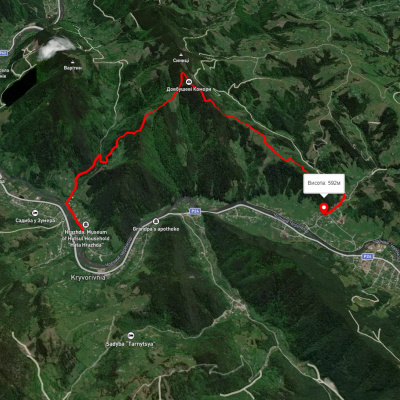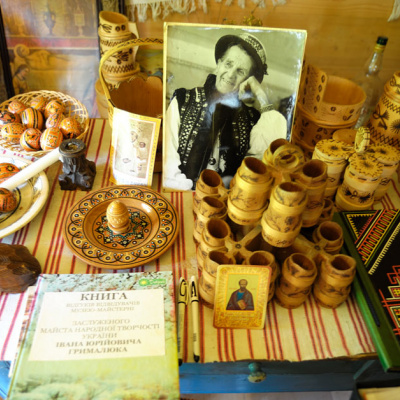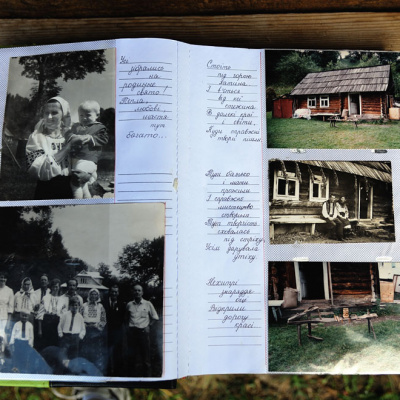Ivan Hrymalyuk's museum-workshop (River)
Wood burning is undoubtedly one of the oldest ways of decorating wooden utensils and other household items. Its use dates back to time immemorial, but wood is a relatively fragile material and wears out quite quickly with constant use, so household items older than 100-120 years are rare. Antique items marked with special marks applied with hot metal stamps acquired a certain magical meaning - in this simplest way they became amulets of household life and those objects that came into contact with them.
Stamps were used to brand cattle as a sign of ownership and to protect them from theft. Different symbols were used to mark details of folk architecture, furniture, and agricultural implements. But the most widespread was burning on cooperage wooden utensils. Over time, burning gradually loses its magical meaning. The original meaning of the burned signs melts away in people's memory and they turn into ordinary decor.
In the Hutsul region, burning eventually emerged as a separate type of artistic craft. Village coopers, each to the best of their ability, decorated the finished products and, having seen the popularity of this type of product, improved the technology and enriched the decor with new elements. Gradually, a traditional set of ornamental motifs and compositions was developed, characteristic of both artistic burning in general and individual ones for each master.
Ancient products were anonymous: burning was not considered a high craft and was not marked by prestige (to some extent, this attitude has been preserved to this day). Elements of burning are already found on the artistic products of the Shkriblyak family and their followers, but they were subordinate, auxiliary in nature and did not play a significant role in the decor.
Ivan Hrymaliuk (1904-1989) was born in the village of Richka, Kosiv district, Ivano-Frankivsk region. He was an outstanding folk master of artistic burning and Honored Master of Folk Art of Ukraine (1982). It was Ivan Hrymaliuk who initiated artistic wood burning, which he used to decorate Bodnar products. He survived all the hardships and wars of modern history, but to the end he remained an exceptionally friendly, bright-hearted person, who met numerous visitors with a friendly, warm attitude and a kind word. Today, his grandson Ivan continues the cooperage traditions.
The Hrymalyuks have been engaged in cooperage since their grandfather and great-grandfather. Ivan took over the craft from his father and started working independently at the age of 14. In 1940, he was one of the first members of the Kosiv artel "Hutsulshchyna" and the artel's branch in Rika. He also worked in the Kosiv artistic and production workshops of the Ukrainian SSR.
He started making coinage when he was a teenager and gradually acquired such a skill that at some points he could work almost without looking at his hands, while communicating with his guests or family members at home. He was well aware of the physical and technological properties of wood, particularly spruce and ash, which are mainly used in cooperage. When harvesting the material, he took into account the season, the time of year, the area in the forest, its position to the sun, and the age of the tree, so his products were durable in use, did not dry out much, and retained their original shape.
He made the tools and accessories for his work himself - there are few of them, they are simple and do not require special precision, but they need a rigid, durable construction. First of all, it is a "hanging table" - a massive bench with a pedal clamp for fixing the "dogs" - rivets of the sidewalls. A sharp, arched, two-handed "axle knife" cut the rivets to the desired thickness and shape. A slat cutter was used to cut a groove in the bottom, and a special device held the rivets in a circular pattern as they were inserted.
To decorate his works, he used the so-called pysaky - simple metal stamps forged by a blacksmith (some of them were still his father's, Yurii Lukianovych's) and two or three figured parts of various mechanisms (e.g. gears), which he attached to iron bars with wooden handles. The master used no more than a dozen of them in active use. This is the entire range of tools of his creative "laboratory", but thousands of decorative and applied products were made with their help. They were characterized by a feature that is inherent in the most talented masters and which art historians call the organic unity of the form of the object and its decoration. They are saturated with the author's good positive energy, and it is pleasant to hold them in your hands, feeling the warmth of the master's soul.
The nomenclature of the most commonly used elements of Ivan Hrymalyuk's ornamentation includes "stars", "curves", simple and double (double), "windows", "cones", "leaves", "nomads", "tresunky" (fan-shaped inflorescences), "rouge", "eye", "chain", etc. At the request of museums, Ivan Hrymaliuk made a board layer with elements and motifs of his ornament, signing them with letters using the same burning method.
One of these layers has been preserved in his modest old workshop, which has now been transformed into a kind of memorial museum thanks to the Department of Artistic Woodworking of the Kosiv Institute of Decorative and Applied Arts, headed by its director, Yosyp Pryimak. A plaque at the entrance is dedicated to his memory.
The list of works includes konovky (water vessels) of various sizes, milking pots, baskets, rohachy (original dishes with two ears), scoops, salt shakers, twins, triplets, and quadruplets with one central handle, buckets, paskovnyks, and more. For fun, as he himself put it, Hrymaliuk made a kind of "slide"-a two-tiered structure of sixteen vessels, all of which were fortified around a common cross-shaped base. The work required great skill and constructive calculation.
Among his products are konovki, harkyky, berbenytsi, barrels, chamfers, horns, salt shakers, tepees, milkers, baskets, twins, paskovtsi, spooners, counters, buckets, butter dishes, scoops, ladles, and vases. Participant in numerous all-Union, regional and international exhibitions: USA, Canada, Bulgaria, Hungary, Yugoslavia, Poland, Great Britain.
Hrymaliuk's works are kept in many museums in Ukraine, Russia, Belarus, and Estonia.
There is good news in the artistic life of Ukraine: the museum-workshop of the Honored Master of Folk Art of Ukraine Ivan Hrymaliuk has been opened.
This event is connected with the village of Richka in Kosiv region. Here, the famous cooperage and firing master was born, lived and created artistic items: horsehairs, pots, spoons, salt shakers, shepherds, milkers, sugar bowls, buckets and other household items, which he decorated with ornamental motifs made using the firing technique.
The opening of the museum is dedicated to the 105th anniversary of the birth of the original artist (born on September 11, 1904). This good deed was done thanks to his daughter Maria, who cherishes the memory of her talented, modest and kind father.
He passed away on September 8, 1989.
At the opening ceremony of the museum, which was hosted by Maria Kopchuk, the head of the village of Richkiv, Yosyp Pryimak, author of the monograph "Ivan Hrymaliuk," Kateryna Karkadym, author of the booklet, Yurii Dzhuraniuk, Larysa Berezka, Vasyl Shkurhan, Mykola Martyshchuk, Mykhailo Trushyk, Stepan Stefurak, Ivan Kishchuk, Mariia Hryniuk, Sviatoslav Martyshchuk, and his grandson Ivan spoke about the life and artistic activity of the master. Vasyl Toniuk, Honored Master of Folk Art of Ukraine, one of the few masters of artistic woodworking of venerable age, shared his memories of Ivan Yuriiovych as a talented man about a talented man.
The participants of the holiday were greeted with Hutsul melodies and songs by amateurs of the school ensemble "Kytychka" under the direction of teacher Mykola Martyshchuk, who was gifted in music, singing and poetry, violinist Mykhailo Khimyak, cymbalist Petro Hrymalyuk, great-grandson of the famous master Ivanko, who, by the way, cut the ribbon during the opening of the museum.
Thanks to Kateryna Karkadym, the film Bondareva Autumn by the Kolomyia Vatra Film Studio, filmed in the penultimate years of the master's life, was shown. At the gala event, everyone had the opportunity to see not only the works of I. Hrymaliuk, but also Maria Hryhorchuk and her son Ivan.
In pre-war times, Ivan Hrymaliuk transported or even carried his products on his shoulders to the resort of Vorokhta, where he found demand for small burned items among vacationers. At the same time, Norbert Okolowski, a colonel in the Polish army known as a collector who settled in Rika and bought Hutsul items for his collection, became interested in him. Hrymaliuk, on his request, performed some of the works from his assortment.
During his lifetime, apprenticeships did not work out well: those who wanted to learn the craft, realizing that they could not earn much money from it, sought another life. Ivan Yuriiovych was most sorry for one girl, who, according to him, had a natural inclination to the profession of cooper, but family circumstances led her in a different direction.
In the late 70s and 80s, Ivan Hrymaliuk's brother Vasyl was successfully engaged in firing. (1907-1990) Vasyl's products are decorated with a clear, rich, though somewhat dry ornament, a certain knowledge of composition is noticeable, and the cooper's base is marked by a strong professional performance and logical form.
After the Second World War, Ivan Hrymaliuk worked at the branch of the Hutsulshchyna Production and Art Association, Kosiv Art and Production Workshops, participated in numerous exhibitions, received various awards, diplomas, and other honors. In 1982, he was awarded the title of Honored Master of Folk Art of Ukraine. I. Hrymaliuk's works can be found among collectors in many countries of Europe and America.
Accommodation around Ivan Hrymalyuk's museum-workshop (River):
Які маршрути проходять повз Ivan Hrymalyuk's museum-workshop (River)?
Пропонуємо пройти такі туристичні (пішохідні) маршрути через/біля Ivan Hrymalyuk's museum-workshop (River): Шешори - Росохата, Писаний Камінь – с. Буковець, с. Буковець – Писаний Камінь – с. Буковець, с. Космач, через г. Ротило, г. Грегіт, г. Біла Кобила до с.Буковець, На Довбушеві Комори, Дорога опришків
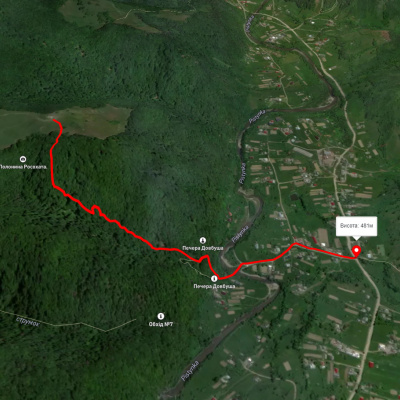
Шешори - Росохата
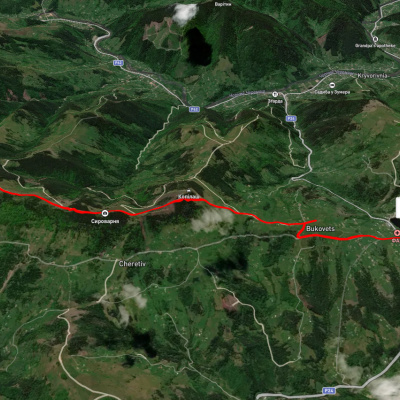
Писаний Камінь – с. Буковець
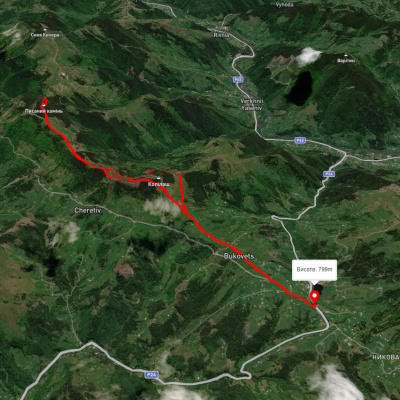
с. Буковець – Писаний Камінь – с. Буковець
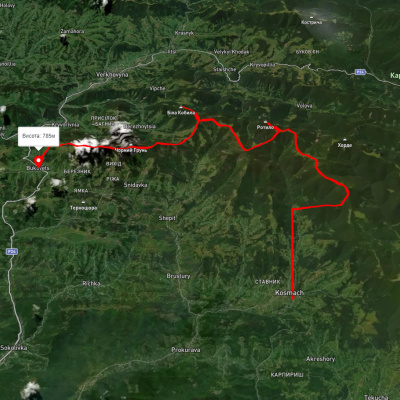
с. Космач, через г. Ротило, г. Грегіт, г. Біла Кобила до с.Буковець
